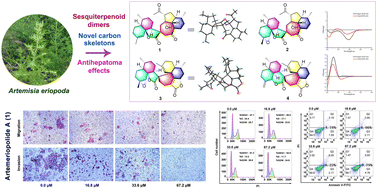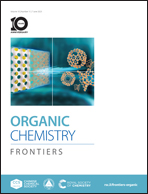Artemeriopolides A–D, two types of sesquiterpenoid dimers with rare carbon skeletons from Artemisia eriopoda and their antihepatoma cytotoxicity†
Abstract
Artemeriopolides A–D (1–4), four novel cadinane sesquiterpenoid dimers featuring the rare 2-oxaspiro[4.6]undecan-1,7-dione, 2-oxaspiro[4.5]decan-1-one, and 2-oxaspiro[5.5]undecan-1-one ring systems, were isolated from Artemisia eriopoda. They are classified as two types of carbon skeletons and the structures and absolute configurations were elucidated by extensive spectral data, ECD calculations, and X-ray crystallography analyses. Antihepatoma cytotoxicity was assayed for compounds 1–4, which suggested that compound 1 was the most active against HepG2, Huh7, and SK-Hep-1 cells with IC50 values of 33.6, 59.9, and 56.9 μM, respectively. The Transwell assay indicated that artemeriopolide A (1) inhibited cell migration and invasion in HepG2 cells with migration ratios of 89.9%, 62.4%, and 62.2% and invasion ratios of 46.8%, 43.6%, and 15.7% at the concentrations of 16.8, 33.6, and 67.2 μM, respectively. Western blot assay demonstrated that artemeriopolide A (1) downregulated the expression of vimentin and N-cadherin and upregulated the expression of E-cadherin. The flow cytometry analysis in HepG2 cells suggested that artemeriopolide A (1) induced G0/G1 cell cycle arrest with the percentage of cells in the G0/G1 phase ranging from 47.1% to 50.5%, 51.2%, and 54.5% and promoted cell apoptosis with apoptosis ratios from 4.8% to 6.1%, 8.2%, and 9.8%.

- This article is part of the themed collection: 2023 Organic Chemistry Frontiers HOT articles


 Please wait while we load your content...
Please wait while we load your content...